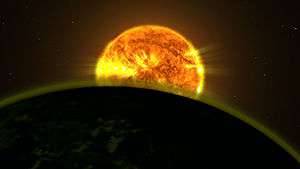List of extrasolar candidates for liquid water
Extraterrestrial liquid water in the Solar System is likely uncommon, although it has been hypothesized to exist in some of its moons, and to have formerly existed on Mars and Venus.[2][3] Extrasolar liquid water has not yet been found to exist. The following list contains candidates from the list of confirmed exoplanets.
Most known extrasolar planetary systems appear to have very different compositions from the Solar System, though there is probably sample bias arising from the detection methods.
The goal of current searches is to find Earth-sized planets in the habitable zone of their planetary systems (also sometimes called the Goldilocks zone).[4] Planets with oceans could include Earth-sized moons of giant planets, though it remains speculative whether such 'moons' really exist. The Kepler telescope might be sensitive enough to detect them.[5] But there is evidence that rocky planets hosting water may be commonplace throughout the Milky Way.[6]
Summary
| Image | Planet | Star | Mass (x M⊕) |
Temp. (surf. mean, K) |
Distance (ly) |
Age (gy) |
Orbit (days) |
Discovery (year) |
Notes |
|---|---|---|---|---|---|---|---|---|---|
 |
Earth | Sun | 1 | 288 | 0 | 4.54 | 365 | For comparison. | |
 |
55 Cancri e | 55 Cancri | 8.63 | <2000 | 41 | 7.4–8.7 | 0.73 | 2004 | |
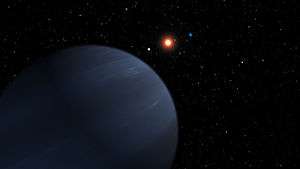 |
55 Cancri f | 55 Cancri | ~47.5 | 200–300 | 41 | 7.4–8.7 | 260 | 2005 | |
| AA Tauri | 456.4 | ||||||||
| Alpha Centauri B | 4.37 | ||||||||
| COROT-7b | COROT-7 | <9 | 1300–1800 | 489 | 1.2–2.3 | 0.85 | 2009 | ||
| COROT-9b | COROT-9 | 266.9 | 250–430 | 1500 | 95 | 2010 | |||
| GD 61 | 150 | ||||||||
 |
Gliese 581 c | Gliese 581 | 5.5 | 700–1000 | 20 | 7–11 | 12.9 | 2007 | |
 |
Gliese 581 d | Gliese 581 | 6.98 | ~181 | 20 | 7–11 | 66.8 | 2007 | Disputed. |
 |
Gliese 581 g | Gliese 581 | 2.2 | 242–261 | 20 | 7–11 | 32 | 2010 | Disputed. |
| Gliese 667 Cc | Gliese 667 C | 3.7 | 277.4 | 23 | >2 | 28.1 | 2011 | ||
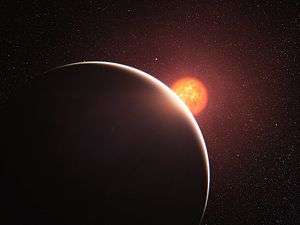 |
GJ 1214 b | GJ 1214 | 7 | 393–555 | 42 | 6 | 1.58 | 2009 | |
 |
HD 28185 b | HD 28185 | 1811.46 | 138 | 7.5 | 379.6 | 2001 | ||
 |
HD 85512 b | HD 85512 | 3.6 | 298 | 36 | 5.6 | 54.43 | 2011 | |
 |
MOA-2007-BLG-192Lb | MOA-2007-BLG-192L | 3.3 | 3000 | 2008 | ||||
| Kapteyn b | Kapteyn's Star | 4.8 | 205 | 12.8 | ~11 | 48.61 | 2014 | ||
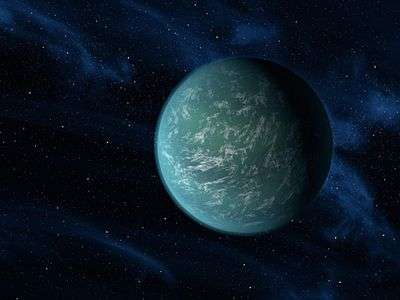 |
Kepler-22b | Kepler-22 | <52.8 | 295 | 600 | ~4 | 289.8 | 2011 | |
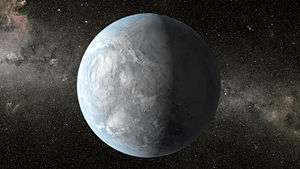 |
Kepler-62e | Kepler-62 | 5 | ~270 | 1200 | 7 | 122.3 | 2013 | |
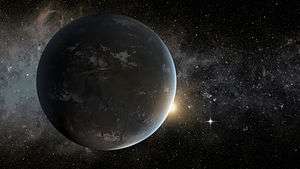 |
Kepler-62f | Kepler-62 | 1.413–2.80 | ~208 | 1200 | 208 | 267.2 | 2013 | |
| Kepler-69c | Kepler 69 | ~6 | 548 | 2700 | 0.4 | 242.4 | 2013 | ||
 |
Proxima b | Proxima Centauri | 1.27 (min.) | 234 | 4.2 | <4.85 | 11.1 | 2016 | |
| TW Hydrae | 176 | ||||||||
Description (alphabetical order)
55 Cancri e
55 Cancri e orbits very close to 55 Cancri, but observations suggest that it is 30% supercritical water, a global ocean.[7] Follow-up analysis of its transit failed to detect traces of either water or hydrogen[8] making it highly unlikely that liquid water is present at the surface.
55 Cancri f
55 Cancri f is a large planet orbiting in the habitable zone of the star 55 Cancri A. Its composition is unknown but it is believed to be a gas giant. If it has rocky moons, these could have liquid water.[9]
There is also a gap in the orbits of that system's five (known) planets which might contain something more Earth-like. If it exists, it cannot be detected by present methods, though these are constantly being improved.
AA Tauri
AA Tauri is a young star, less than a million years old and a typical example of a young star with a protoplanetary disk. Astronomers have recently found the spectral signatures of water vapor, plus three simple organic molecules – hydrogen cyanide, acetylene and carbon dioxide.[10] Solid bodies condensing from the disk should have liquid water, if they are the right distance from the star.
Alpha Centauri B
The nearby star Alpha Centauri B may have a planet with oceans.[11] This is speculative: the only confirmed planet in the system is Alpha Centauri Bb, which would be much too hot.
COROT-7b
COROT-7b is an exoplanet less than twice the size of Earth orbiting a Sun-like star very closely. It was discovered by the CoRoT space telescope and was announced to the public on 3 February 2009. The surface is predicted to be in the range of 1,000–1,500 degrees Celsius, but since its composition is not known it could be covered in molten lava or enshrouded in a thick water vapour cloud layer. The planet could also be made up of water and rock in almost equal amounts. If COROT-7b is water-rich it could be an ‘ocean planet’.[12]
COROT-9b
COROT-9b has been called a temperate exoplanet as its cloudtop temperature ranges from −20 degrees to 160 degrees Celsius. It is the size of Jupiter but a similar distance as Mercury is from our Sun. There are other similar planet cases known, but this planet can be studied in detail because it transits its star. Although it is mostly made of hydrogen and helium it may contain up to 20 Earth masses of other elements, including water and rock at high temperatures and pressures.[13]
GD 61
GD 61 is a white dwarf star, with an asteroid which has given the first direct evidence of a water-rich rocky planetary body outside the Solar System. The asteroid may be part of the debris from what might once have been a rocky planet with either ice or oceans.[14]
Previous detections of water vapor have been in giant planets. This find confirms that rocky planets with water exist outside of the Solar System.

Gliese 581 c, d and g
Gliese 581 c, a world five times the size of the Earth, was originally reported to be the right distance from its sun for liquid water to exist on the planet's surface.[15] Since it does not transit its sun, there is no way to know if there is any water there.
Later work suggests that Gliese 581 c would probably be too hot for liquid water. It was then suggested that Gliese 581 d might be warm enough for oceans if a greenhouse effect was operating.[16] Gliese 581 d is eight times the mass of the Earth and might have a thick atmosphere.
Gliese 581 d looks an even better candidate. The orbital period was originally estimated at 83 days and has now been revised to 66 days.[17] This was announced along with another new world, Gliese 581 e, which is next to twice the mass of Earth but too close to its sun for liquid water. In May 2011, a new study suggested that the planet might have a thick atmosphere, oceans and even life.[18]
The unconfirmed planet Gliese 581 g is another good candidate. This planet is estimated to be between three and four times as massive as the earth, and as such it is too small to be a gas giant. The orbital period is estimated at 37 days, which places its orbit right in the middle of the habitable zone of the star Gliese 581.[19]
Gliese 667 C - three planets
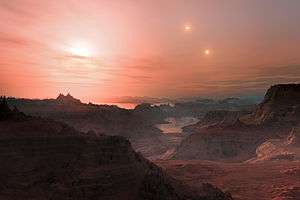
Gliese 667 Cc was originally described as one of two 'super-Earth' planets around Gliese 667 C, a dim red star that is part of a triple star system. The stars of this system have a concentration of heavy elements only 25% that of our Sun's. Such elements are the building blocks of terrestrial planets so it was thought to be unusual for such star systems to have an abundance of low mass planets.[21] It seems that habitable planets can form in a greater variety of environments than previously believed.
Gliese 667 Cc, in a tight 28-day orbit of a dim red star, must receive 90% of the light that Earth receives, but most of its incoming light is in the infrared, so a higher percentage of this incoming energy should be absorbed by the planet. The planet is expected to absorb about the same amount of energy from its star that Earth absorbs from the Sun, which would allow surface temperatures similar to Earth and perhaps liquid water.[22]
Further work published in June 2013 suggests that the system has six planets, and that three of them are in the habitable zone.[23]
GJ 1214 b
GJ 1214 b was the second exoplanet (after CoRoT-7b) to have an established mass and radius less than those of the giant Solar System planets. It is three times the size of Earth and about 6.5 times as massive. Its low density indicated that it is likely a mix of rock and water,[24] and follow-up observations using the Hubble telescope now seem to confirm that a large fraction of its mass is water, so it is a large waterworld. The high temperatures and pressures would form exotic materials like 'hot ice' or 'superfluid water'.[25][26]
HD 28185 b
HD 28185 b was the first exoplanet to be detected in the habitable zone.[27] The planet has only been detected indirectly, but is believed to be a gas giant, with no solid surface. Some scientists have argued that it could have moons large and stable enough to have oceans.[28]
HD 85512 b
HD 85512 b was discovered in August 2011. It is larger than Earth, but small enough to be probably a rocky world. It is on the borders of its star's habitable zone and might have liquid water, and is a potential candidate for a life-supporting world.[29][30]
MOA-2007-BLG-192Lb
MOA-2007-BLG-192Lb is a small planet orbiting a small star. It is about 3 Earth masses, currently the second smallest detected extrasolar planet orbiting a normal star, after Gliese 581 e.
The planet orbits its host star or brown dwarf with an orbital radius similar to that of Venus. But the host is likely to be between 3,000 and 1 million times fainter than the Sun, so the top of the planet's atmosphere is likely to be colder than Pluto. However, the planet is likely to maintain a massive atmosphere that would allow warmer temperatures at lower altitudes. It is even possible that interior heating by radioactive decay would be sufficient to make the surface as warm as the Earth, but theory suggests that the surface may be completely covered by a very deep ocean.[31]
Kapteyn b
Kapteyn b is a super-Earth orbiting within the habitable zone of Kapteyn's Star, which is 13 light-years away and is 11 billion years old.[32]
Kepler-22b
Kepler-22b is a planet 2.4 times the size of the Earth, with an estimated temperature of 22 °C. It was one of 54 candidates found by the Kepler telescope and reported in February as potentially habitable. It is the first of these to be formally confirmed using other telescopes. Its composition is currently unknown.[33]
Kepler-62e and Kepler-62f
The star Kepler-62 has five planets, two of which are the right distance from the star to have liquid water and potentially sustain life.[34]
Kepler-62f is only 40 percent larger than Earth, making it the exoplanet closest to the size of our planet known in the habitable zone of another star. Kepler-62e orbits on the inner edge of the habitable zone and is roughly 60 percent larger than Earth.[35] Both are assumed to be rocky planets, but since the star is 1200 light-years away, it is hard to be sure.
Kepler-69c
This large rocky planets is one of two known to be orbiting the star Kepler 69, which is similar to our sun. It is believed to be in the star's habitable zone.
It is 70% more massive than the Earth and has a 242-day orbit, similar to that of Venus.
NASA announced its discovery on 18 April 2013, along with the two Earth-like planets of Kepler 62.[35]
Kepler (other results)
Among the 1,235 possible extrasolar planet candidates detected by NASA's planet-hunting Kepler space telescope during its first four months of operation, 54 are orbiting in the parent star's habitable 'Goldilocks' zone where liquid water could exist.[36] Five of these are near Earth-size, and the remaining 49 habitable zone candidates range from twice the size of Earth to larger than Jupiter.[37]
Proxima b
Proxima Centauri b, the nearest known exoplanet, is in the habitable zone of its host star, and might contain liquid water.[38][39] More details about the planet's physical conditions are needed for a proper evaluation of its habitability.[40][41][42]
TW Hydrae
TW Hydrae is a very young star is in the process of forming a planetary system. Scientists have now detected clouds of water vapour cold enough to form comets. This could eventually deliver oceans to dry planets, which is believed by most scientists to have happened on the early Earth and other rocky planets.
Water vapour has previously been detected in planet-forming disks, but too warm to form comets. This cloud is cool enough and is estimated to contain thousands of Earth-oceans' worth of water.[43]
See also
References
- ↑ "Hubble traces faint signatures of water in exoplanet atmospheres (artist's illustration)". ESA/Hubble Press Release. Retrieved 5 December 2013.
- ↑ "Mars Probably Once Had A Huge Ocean". Sciencedaily.com. 2007-06-13. Retrieved 2012-01-22.
- ↑ Owen, (2007), news.nationalgeographic.com/news/2007/11/071128-venus-earth_2.html
- ↑ "Habitable planets may be common". Newscientist.com. Retrieved 2012-01-22.
- ↑ "The hunt for habitable exomoons". Astronomynow.com. 2009-09-04. Retrieved 2012-01-22.
- ↑ "Water, water everywhere". Astronomynow.com. Retrieved 2012-01-22.
- ↑ "Astrophile: Supercritical water world does somersaults". Newscientist.com. Retrieved 2012-01-22.
- ↑ D. Ehrenreich; et al. (October 2, 2012). "Hint of a transiting extended atmosphere on 55 Cancri b". Astronomy & Astrophysics. arXiv:1210.0531
 . Bibcode:2012A&A...547A..18E. doi:10.1051/0004-6361/201219981.
. Bibcode:2012A&A...547A..18E. doi:10.1051/0004-6361/201219981. - ↑ Bowdler, Neil (2007-11-07). "Astronomers discover new planet". BBC News. Retrieved 2012-01-22.
- ↑ "Organics and water found where new planets may grow". Spaceflightnow.com. Retrieved 2012-01-22.
- ↑ Star next door may host a 'superhabitable' world
- ↑ "CoRoT discovers most Earth-like exoplanet yet". Astronomynow.com. 2009-02-03. Retrieved 2012-01-22.
- ↑ "Sizing up a temperate exoplanet". Astronomynow.com. 2010-03-17. Retrieved 2012-01-22.
- ↑ Water Discovered in Remnants of Extrasolar Rocky World Orbiting White Dwarf
- ↑ "New Planet Could Harbor Water and Life". Space.com. 2007-04-24. Retrieved 2012-01-22.
- ↑ "Scientists might have picked right star, wrong world for hosting life". MSNBC. 2007-06-18. Retrieved 2012-01-22.
- ↑ "Sibling worlds may be wettest and lightest known". Newscientist.com. Retrieved 2012-01-22.
- ↑ "Exoplanet near Gliese 581 star 'could host life'". BBC News. 2011-05-17. Retrieved 2012-01-22.
- ↑ "NASA and NSF-Funded Research Finds First Potentially Habitable Exoplanet". Release 10-237. NASA. 2010-09-29.
- ↑ "Many Billions of Rocky Planets in the Habitable Zones around Red Dwarfs in the Milky Way". ESO Press Release. Retrieved 29 March 2012.
- ↑ New Super-Earth Detected Within the Habitable Zone of a Nearby Cool Star
- ↑ Super-Earth orbits in habitable zone of cool star
- ↑ Three Planets in Habitable Zone of Nearby Star: Gliese 667c Reexamined
- ↑ "The small planet with a thick coat". Astronomynow.com. 2009-12-17. Retrieved 2012-01-22.
- ↑ Distant 'waterworld' is confirmed
- ↑ Hubble Reveals a New Class of Extrasolar Planet
- ↑ Jones, B. W.; Sleep, P. N.; Underwood, D. R. (2006). "Habitability of Known Exoplanetary Systems Based on Measured Stellar Properties". The Astrophysical Journal. 649 (2): 1010. arXiv:astro-ph/0603200
 . Bibcode:2006ApJ...649.1010J. doi:10.1086/506557.
. Bibcode:2006ApJ...649.1010J. doi:10.1086/506557. - ↑ Barnes, J. W.; O’Brien, D. P. (2002). "Stability of Satellites around Close‐in Extrasolar Giant Planets". The Astrophysical Journal. 575: 1087. arXiv:astro-ph/0205035
 . Bibcode:2002ApJ...575.1087B. doi:10.1086/341477.
. Bibcode:2002ApJ...575.1087B. doi:10.1086/341477. - ↑ "Exoplanet Looks Potentially Lively". Scientificamerican.com. Retrieved 2012-01-22.
- ↑ "'Super-Earth,' 1 of 50 Newfound Alien Planets, Could Potentially Support Life". News.yahoo.com. 2011-09-12. Retrieved 2012-01-22.
- ↑ "Small Planet Discovered Orbiting Small Star". Sciencedaily.com. 2008-06-02. Retrieved 2012-01-22.
- ↑ "Astronomers discover two new worlds orbiting ancient star next door: One may be warm enough to have liquid water". Retrieved 3 October 2015.
- ↑ "Kepler 22-b: Earth-like planet confirmed". BBC News. 2011-12-05. Retrieved 2012-01-22.
- ↑ Kepler telescope spies 'most Earth-like' worlds to date
- 1 2 NASA's Kepler Discovers Its Smallest 'Habitable Zone' Planets to Date
- ↑ "Kepler detects more than 1,200 possible planets". Spaceflightnow.com. Retrieved 2012-01-22.
- ↑ "NASA Finds Earth-Size Planet Candidates in Habitable Zone, Six Planet System". Sciencedaily.com. 2011-02-02. doi:10.1038/nature09760. Retrieved 2012-01-22.
- ↑ Anglada-Escudé, G.; Amado, P. J.; Barnes, J.; Berdiñas, Z. M.; Butler, R. P.; Coleman, G. A. L.; de la Cueva, I.; Dreizler, S.; Endl, M.; Giesers, B.; Jeffers, S. V.; Jenkins, J. S.; Jones, H. R. A.; Kiraga, M.; Kürster, M.; López-González, M. J.; Marvin, C. J.; Morales, N.; Morin, J.; Nelson, R. P.; Ortiz, J. L.; Ofir, A.; Paardekooper, S.-J.; Reiners, A.; Rodríguez, E.; Rodrίguez-López, C.; Sarmiento, L. F.; Strachan, J. P.; Tsapras, Y.; Tuomi, M.; Zechmeister, M. (25 August 2016). "A terrestrial planet candidate in a temperate orbit around Proxima Centauri" (PDF). Nature. 536 (7617): 437–440. doi:10.1038/nature19106. ISSN 0028-0836.
- ↑ Witze, Alexandra (24 August 2016). "Earth-sized planet around nearby star is astronomy dream come true". Nature. pp. 381–382. doi:10.1038/nature.2016.20445. Retrieved 24 August 2016.
- ↑ Clery, Daniel (26 August 2016). "The exoplanet next door". Science News. Retrieved 28 August 2016.
Researchers have already found hundreds of similarly sized planets, and many appear to be far better candidates for hosting life than the one around Proxima Centauri, called Proxima b.
- ↑ Amos, Jonathan (24 August 2016). "Neighbouring star Proxima Centauri has Earth-sized planet". BBC News. Retrieved 25 August 2016.
Just how "habitable" this particular planet really is, one has to say is pure speculation for the time being.
- ↑ Ribas, Ignasi; Bolmont, Emeline; Selsis, Franck; et al. (25 August 2016). "The habitability of Proxima Centauri b: I. Irradiation, rotation and volatile inventory from formation to the present" (PDF). Astronomy & Astrophysics. Retrieved 28 August 2016.
- ↑ "Nearby Planet-Forming Disk Holds Water for Thousands of Oceans". Sciencedaily.com. 2011-10-20. doi:10.1126/science.1208931. Retrieved 2012-01-22.
